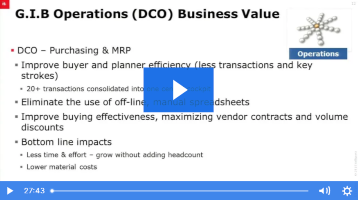Live from SAPinsider Studio: GOJO Industries on Optimizing Production Planning and Knowledge Management
John Hooker of GOJO Industries, producer of Purell, joins SAPinsider Studio at the SCM 2016 event in Las Vegas to discuss the company’s recent move from their home-grown legacy system to SAP ECC 6.0 and the successful SAP add-on and optimization projects that have streamlined production and knowledge management.
Here is an edited transcript of the discussion:
Natalie Miller, SAPinsider: Hi, I’m Natalie Miller with SAPinsider and we’re here at the SCM, CRM, and IoT event in Las Vegas. And I’m joined by John Hooker, Vice President of IT at GOJO Industries. Hi, John, how are you?
John Hooker, GOJO Industries: Good, good. How are you doing?
Natalie Miller: Thank you so much for joining me today.
John: Thanks.
Natalie: I was hoping we could start by you telling us a little about GOJO Industries.
John: You might better know us as Purell. That’s one of our key brands. And we are the market leader for the away-from-home hand hygiene market.
Natalie: We are talking today about GOJO’s recent implementation in moving out of your legacy environment. Can you talk a little about some of the production challenges you were having with that legacy environment?
John: Absolutely. We were on a legacy system that was from 1995, so you can guess that there were a lot of issues with it. Really, it was starting to fail us. We couldn’t grow any further; we couldn’t have any additional locations or manufacturing operations or distribution operations. It was time.
Natalie: Can you talk about the solutions that you chose for this and about the implementation?
John: We went with SAP ECC 6.0. It was really the complete end-to-end ERP system. We also put in APO for demand planning and Vistex for customer program management, and we also used Business Warehouse to help us with our BI needs.
Natalie: You also had an add-on with the G.I.B. Dispo-Cockpit Planning. Can you explain that aspect of the project?
John: Absolutely. We were having problems sequencing our production floor. With our business, you need to line up the different formulations that you’re producing so you don’t have to do a lot of cleaning and sanitation of your production lines. So the G.I.B. planning cockpit gave us the ability to visually see our different process orders, get those lined up correctly so we didn’t need to do those kinds of changeovers. We also used the operations cockpit in G.I.B. As you can guess, all of our products have labels on them and they all say something different, but the different sizes happen to be what they call ‘the base spec’. If you can order the base spec from your suppliers and group those orders together, you get nice volume discounts. And so the operations cockpit helped us do that.
Natalie: And there was a quick ROI on this add-on, correct?
John: Yes, the cost savings that we got on the label savings and then also the reduced changeovers gave us pay back in about six weeks.
Natalie: Wow. So you had an implementation partner for this project, itelligence. Can you talk a little about how they helped facilitate this project?
John: Absolutely. itelligence has been with us from the very beginning. SAP recommended them as a partner when we first started evaluating the SAP applications, and they helped us with our original implementation and have been our key partner since then. They knew what kind of challenges we were having as we were trying to optimize SAP and they recommended the G.I.B applications.
Natalie: itelligence is also your hosting service partner as well, correct?
John: Absolutely. We didn’t want to be in the business of maintaining servers, so itelligence offers a hosting service that made things very easy for us.
Natalie: What are some of the other optimization projects that have been part of this implementation?
John: There’s been quite a few. One of the big ones is the EH&S implementation. We are a regulated organization. Purell is an over the counter drug, so the FDA does regulate and monitor what we do from that perspective. Another optimization project is we have expanded our supply chain. We’ve done some pretty neat things with helping us do finish-to-order – finish our product right at the end of the production cycle so we can differentiate it late in the game. And we’ve done a number of things with business intelligence capabilities and things like that.
Natalie: And what are some of the benefits that you’ve been seeing so far since moving to ECC?
John: Well, really having everything in one place, in one system, one application. We eliminated, probably, 10 or 12 different side systems in addition to just getting rid of our legacy system. Small, home-grown applications to do specific tasks – we were able to move those kinds of things into SAP. And then, really, the big pieces – the knowledge management, because we have all that information in a single place. We don’t have silos of information throughout the business. So everybody has a shared starting point.
Natalie: What’s on the horizon? What’s next in terms of this project?
John: There’s a couple big ones. We are definitely going to be going to SAP HANA late this year, although we’ll probably start that project sometime in December so that we can finish it up in early spring. And then we are also looking at CRM applications as well.
Natalie: Can you share some advice for other companies who are thinking about going into a similar implementation?
John: Absolutely. The first thing you want to do is find a good partner to work with. Set a good scope; understand what your scope is and be firm about either ends of that scope. Don’t add a bunch of things part way through the process. Keep things simple for yourself. I absolutely would not do a lot of customization, especially early on. Really try to understand what SAP can do for you within its configuration limits. It has a lot of flexibility if you look at it that way. The last piece, make sure you have a good change management plan. People have big learning curves when they are going to SAP from other legacy systems. So be patient with everybody. Give them an opportunity to get into the system and play and learn.
Natalie: Great. Well, thank you so much, John. I really appreciate you being here today.
John: Thank you.
Natalie: Again, this is Natalie Miller with SAPinsider, and we’ve been speaking with John Hooker of GOJO Industries.
For more information, visit www.itelligencegroup.com.






